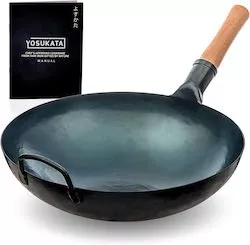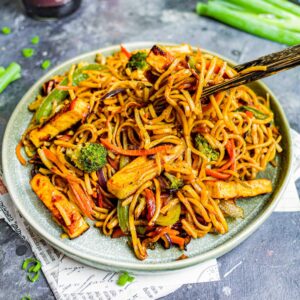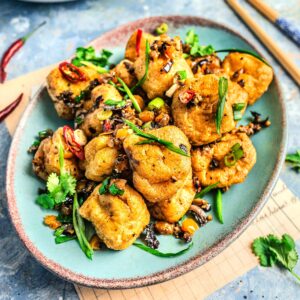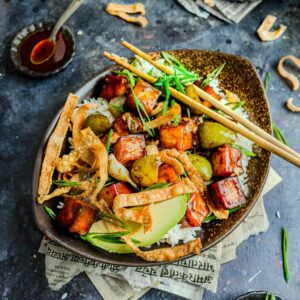Veggie Mei Fun, Vegetable Chow Mai Fun
A time-honoured classic dish, veggie mei fun is made from light rice noodles stir-fried with fresh, crisp vegetables, then tossed with a mixture of sauces that ramps up the umami factor. Like most Chinese dishes, it’s irresistibly good — and unlike most Chinese dishes, it’s also vegan!
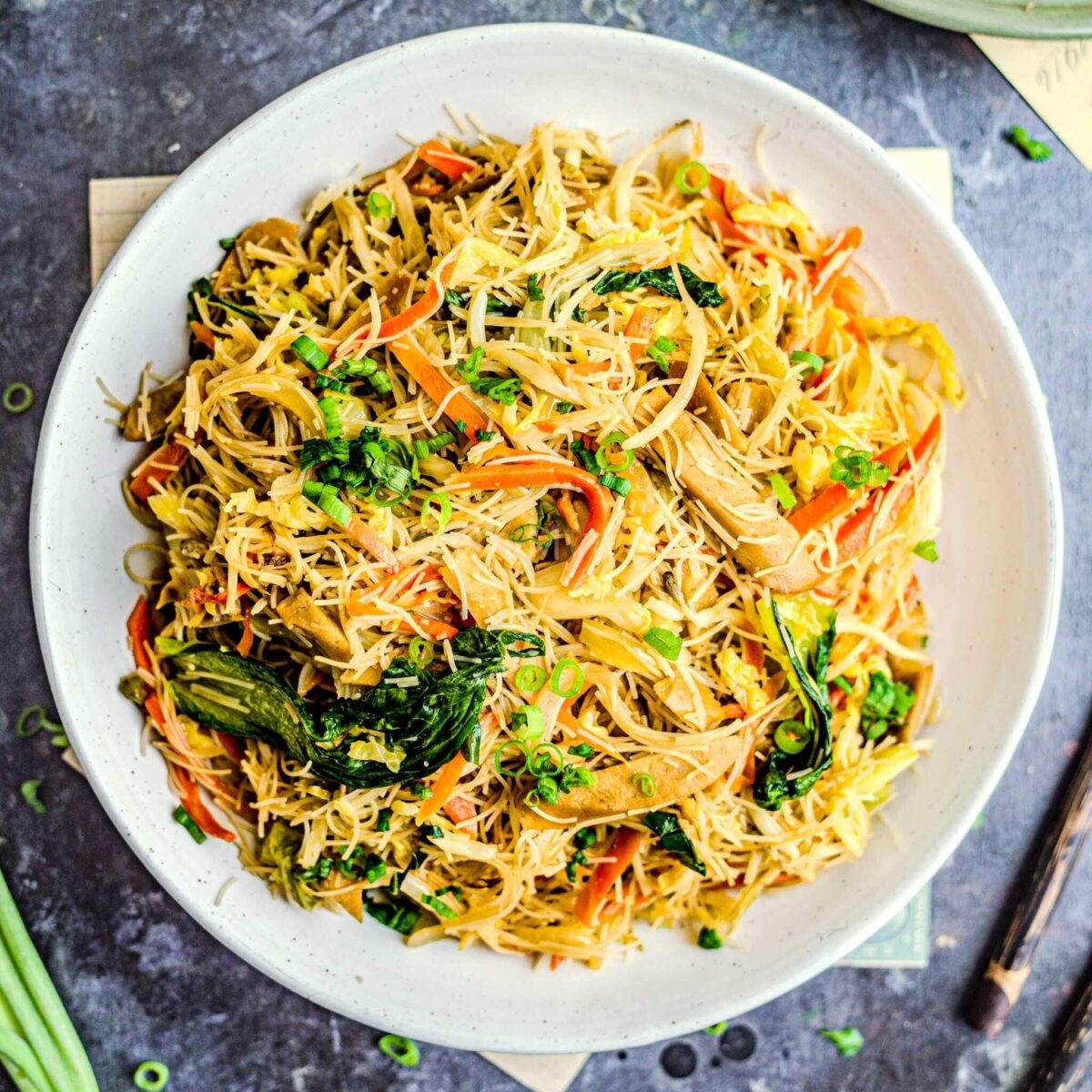
While many people associate Chinese food with indulgence and guilty pleasures (we can thank takeaways and all-you-can-eat buffets for that!), vegetable mei fun is the opposite: light, nourishing, colourful, shockingly healthy, and loaded with nutritional bonuses. But it still retains a restaurant-quality taste.
Subtle flavours are king here. The fresh vegetables sing; the noodles are chewy-tender perfection, and our sauce is exquisitely balanced.
You must add veggie mei fun to your list of weekly staples to master. It’s up there with all-time favourites like soy sauce fried noodles and tantanmen (tan tan ramen).
🤯 This Veggie Mei Fun Recipe is a Must BECAUSE …
❓What is Mei Fun?
Sometimes spelt “mai fun,” mei fun means an ingredient (rice noodles), and a dish made with that ingredient.
It’s a Chinese recipe that’s become popular globally. If you’ve ever eaten at a Chinese buffet, chances are you’ve tried (and fallen in love with!) mei fun.
There are many different recipes for mei fun. Three of the most common include plain mei fun (noodles cooked without sauces); chow mei fun, (stir-fried with umami-packed relishes); and Singapore mei fun, also called Singapore noodles (made by mixing the noodles with curry powder).
This recipe falls under chow mei fun. It’s loaded with vegetables and sauces, while retaining a lighter bite compared to plain chow mein, for example.
🍜 What is Mei Fun Made Of?
Do you cook Asian food regularly? If so, you’ll probably have all these ingredients stocked at home! Otherwise, a quick trip to your local Asian supermarket will sort you out (usually at a fraction of the cost compared to going to a standard supermarket).
You can find the ingredient list (with quantities) in the recipe card, but below we’ll go over what each component adds to the dish, and what you should substitute to accommodate special diets.
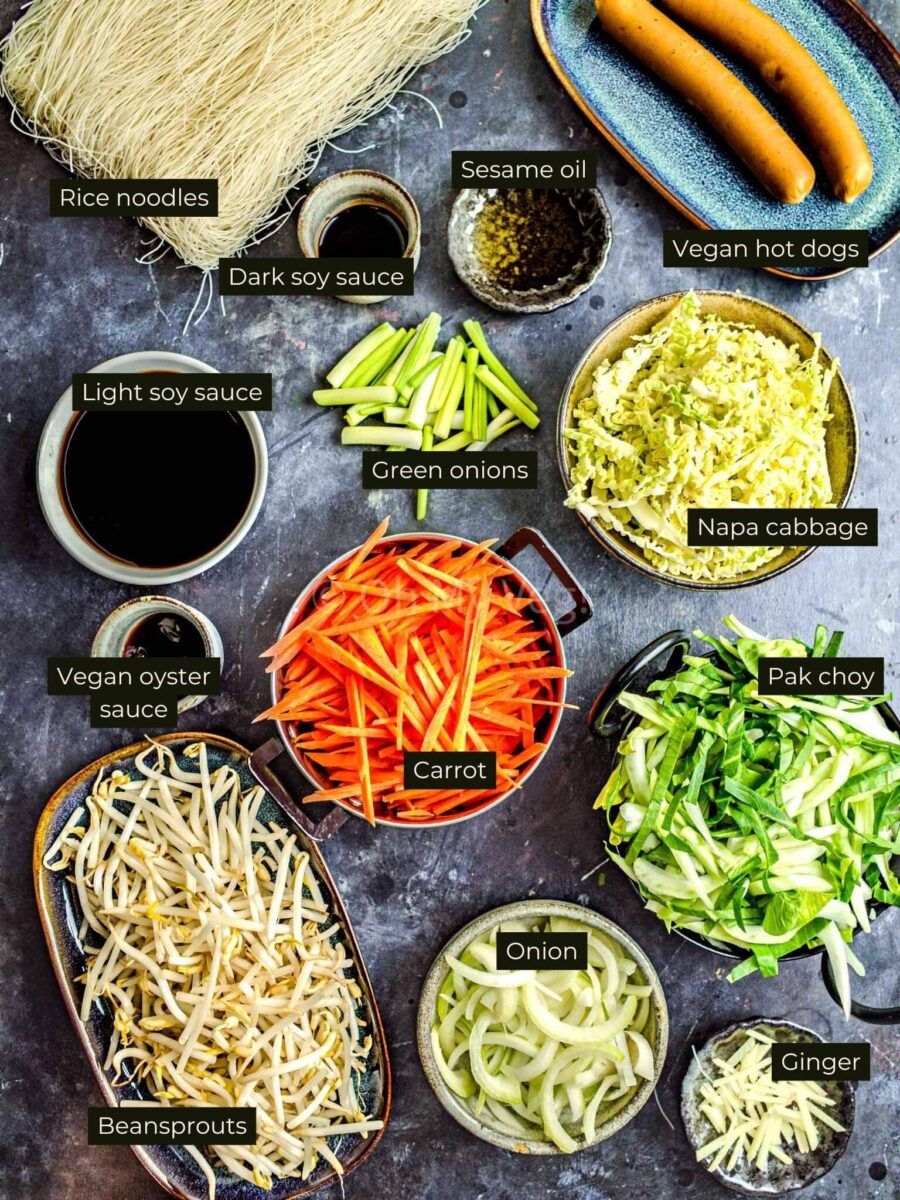
- Dried rice noodles are a must. Buy rice noodles, not glass/cellophane noodles. While they look similar, glass noodles are made from lentil-based starches, while rice noodles are always purely made from rice. Buy the thinnest ones you can find.
- Vegetables such as napa cabbage, carrots, beansprouts, and pak choy (bok choi) are fresh, crunchy, and flavoursome.
- Aromatics include onion and ginger, which add sweetness and peppery warmth, respectively. To finish the dish, green onions (scallions/spring onions) add a mild oniony flavour and vibrant colour.
- Both light and dark soy sauce contribute something unique to vegetable mei fun. While light soy sauce is salty and umami, dark soy has a deeper, more mature, caramelised flavour. Don’t use just one or the other — both are essential!
- Vegan oyster sauce is made from mushrooms, meaning it’s meaty and packed with umami.
- Sesame oil drizzled at the end of the dish and elevates it with an intensely nutty aroma.
- Vegan hot dogs are my protein of choice. They add delicious smokiness and a pleasant meaty chew. Read below for subs!
🥦 Variations and Substitutions
Typically, mei fun contains protein. Traditionally you’ll find chicken, char siu pork, or shrimp is used — but because this blog is vegetarian, we’ve swapped that out for vegan hot dog sausages. If you don’t fancy those, you can use five-spice tofu (find it in local Asian stores), smoked tofu, or homemade extra firm tofu.
Even more straightforwardly, keep it basic with fresh vegetables. You don’t need any extras to make a delicious veggie mei fun.
Speaking of, you can switch up what vegetables you use. In the past, I’ve added broccoli, lettuce (it works surprisingly well instead of napa cabbage!), and kow choi (Chinese garlic chives). Yum!
Vegetable mei fun is a fantastic dish for using leftover veggies in the fridge. It’s ideal for a throw-it-all-in fridge clearout day.
To make the dish gluten free, just switch the dark and light soy sauce for tamari (aka gluten free soy sauce). It’s a must-have for you GF folks.
Veggie mei fun is already 100% vegetarian, vegan, nut free (check with your Dr. about seed oil allergies), and dairy free.
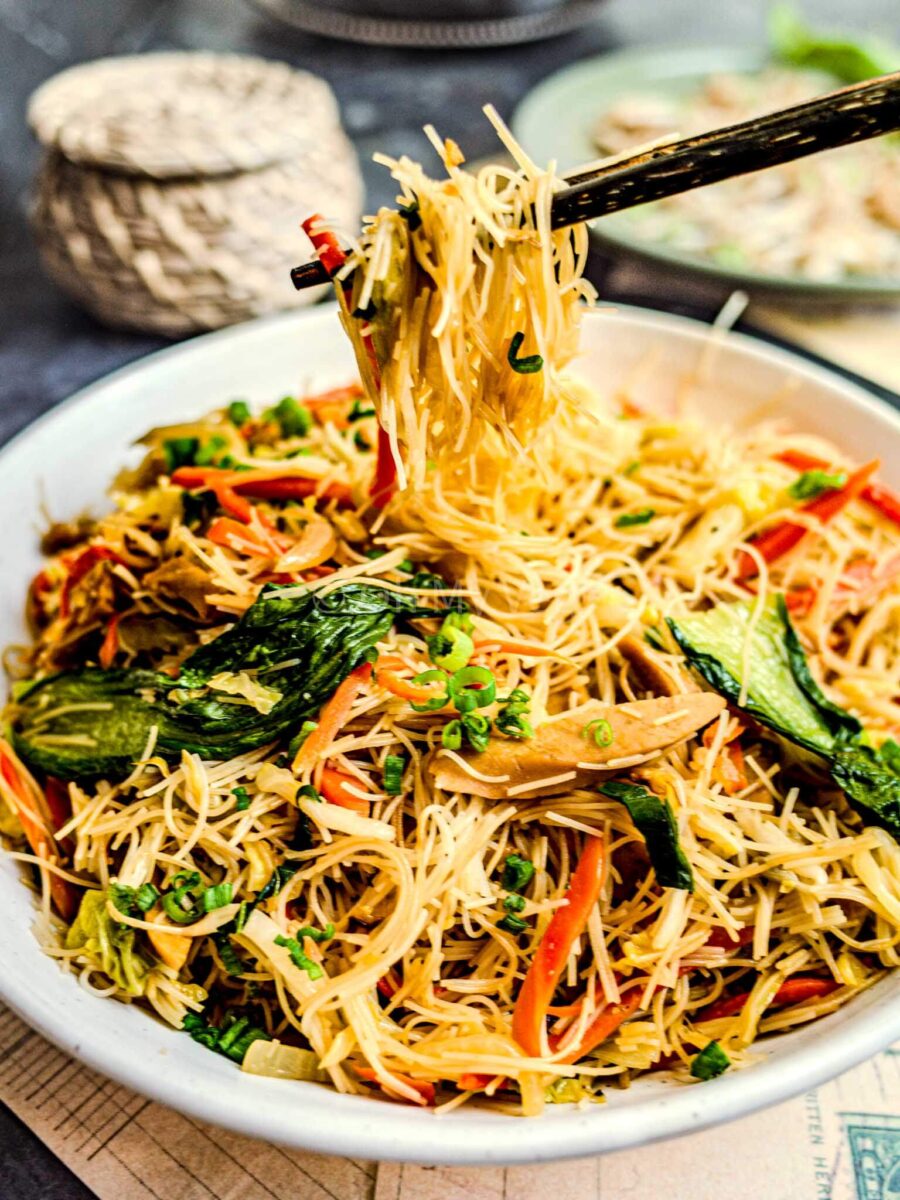
🧑🍳 How to Make Vegetable Mei Fun
I like to split the process of making veggie mei fun into three sections: prepping your ingredients (it’s crucial to do this first; it saves time and stress on every single recipe!), soaking the rice noodles, and giving everything a quick stir-fry. That’s all there is to it. Easy, huh?
There’s a reason I turn to noodle dishes like mei fun, mushroom chow mein and paneer hakka noodles when I’m tired and don’t feel like cooking. They’re so manageable and undemanding, while still hitting those better-than-a-restaurant flavours.
This veggie mei fun is also a super fast recipe. If you’re adept in the kitchen, it should take you less than 20 minutes to whip up this absolute showstopper of a dish.
How to Cook Rice Noodles
We’ve all been there. Clumpy, sticky, gooey rice noodles. That’s not what anyone wants!
When you know how to cook rice noodles correctly, they don’t stick together — they’re super easy to work with.
The best part is that no actual “cooking” is involved. That’s where most people go wrong. No pans, no boiling water. These aren’t egg noodles! Instead, follow these two no-fail steps for all your rice noodle recipes:
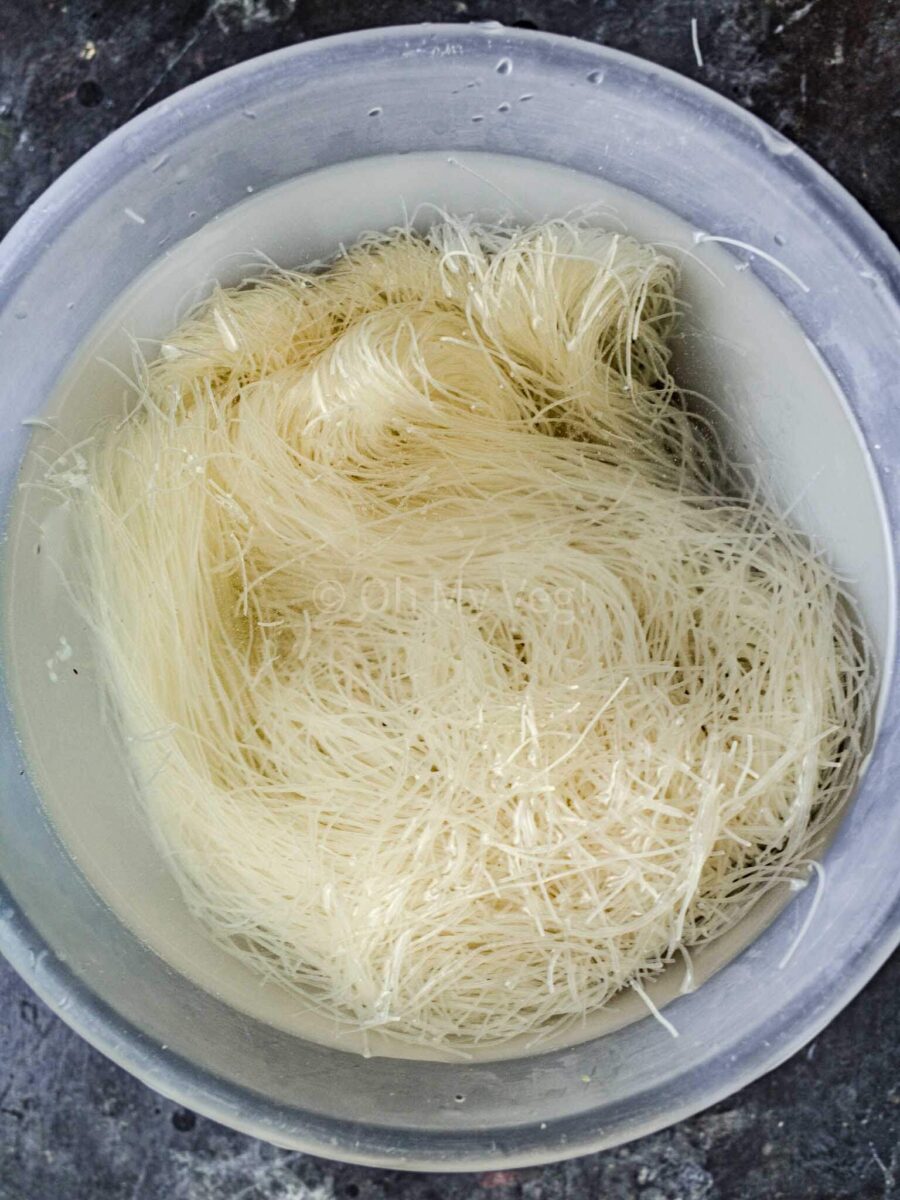
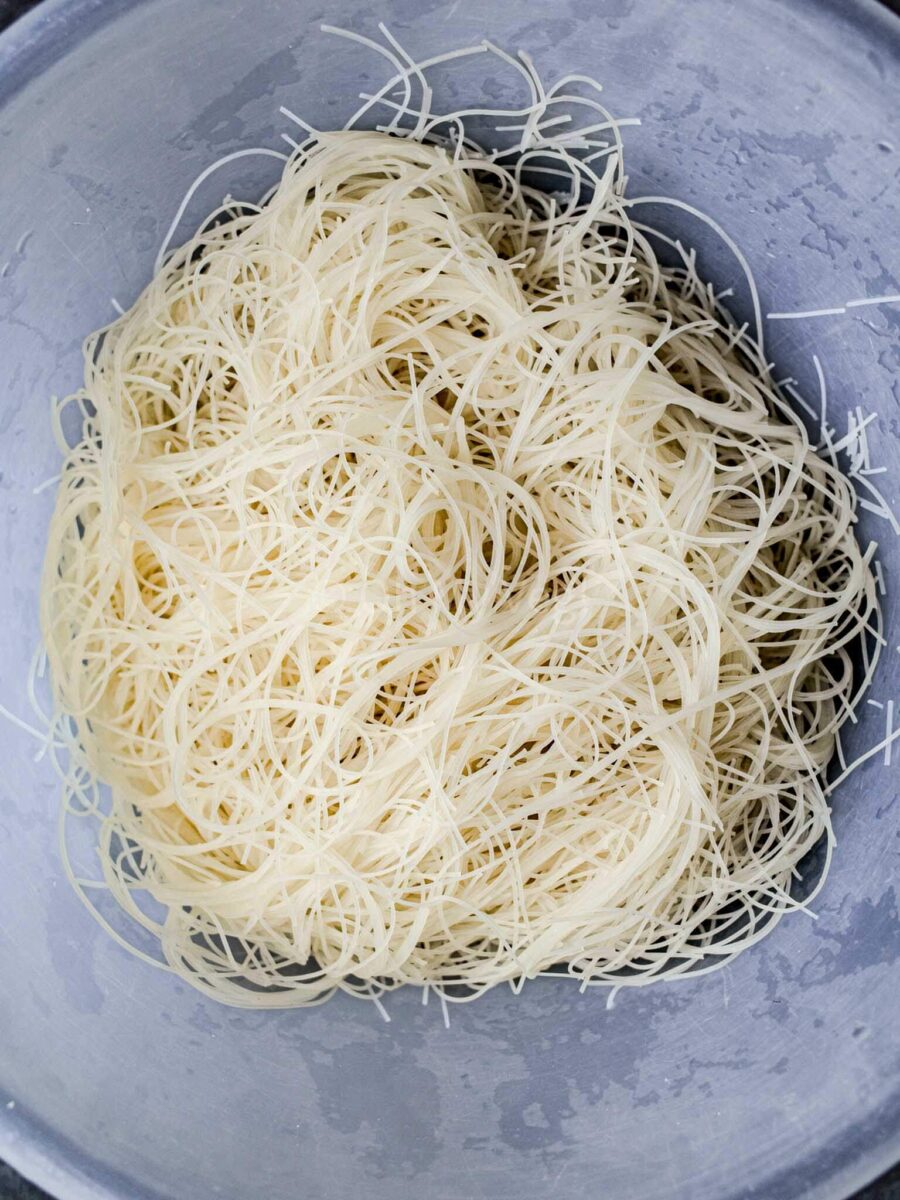
Step one: Add dried rice noodles to a large bowl. Cover with plenty of hot water (not boiling, not cold), and let them soak for 10 minutes.
Step two: Drain the noodles and use them in salads or finish cooking in a wok (as in this recipe).
Instead, you can skip this step and use fresh rice noodles (available from most U.K. supermarkets). However, I find soaking rehydrating dried rice noodles achieves a much better success rate once stir-fried!
Now For the Stir Fry …
- Step one: In a large wok, heat oil until smoking. Add the aromatics (onion, ginger), and stir-fry for a few seconds.
- Step two: Add the hardier vegetables (carrots, pak choy, and napa cabbage) and protein (vegan hot dog sausages) to the pan. Stir-fry for a few minutes on high heat.
- Step three: Throw in the beansprouts and green onions. Stir-fry for 30 seconds.
- Step four: Add the sauces (light and dark soy sauce and vegan oyster sauce). Toss to mix with the vegetables.
- Step five: Toss in your soaked and drained rice noodles. Mix everything to coat the noodles properly.
- Step six: Finish everything off with a drizzle of sesame oil and finally sliced green onions (if you like).
Tips for Perfect Veggie Mei Fun
Above all else, avoid mushy noodles by cooking your rice noodles correctly (detailed above). After soaking, your rice noodles should be firm — they’ll finish cooking in the pan. Get this wrong, and you’ll easily completely ruin mei fun.
For restaurant-style mei fun, you need to infuse your dish with wok hei.
Learning about wok hei made an immeasurable difference to my Asian cookery skills. If something is missing from your stir-frys, wok hei is probably the missing piece.
Wok hei translates to mean “breath of the wok.” Sounds poetic, right? But implementing the technique is surprisingly easy: Use a seasoned wok, heat until smoking, then add cold oil. Constantly toss your ingredients while stir-frying, and you’ll instantly bestow your dish with all the smoky, caramelised flavours of the hot wok. It’s magic!
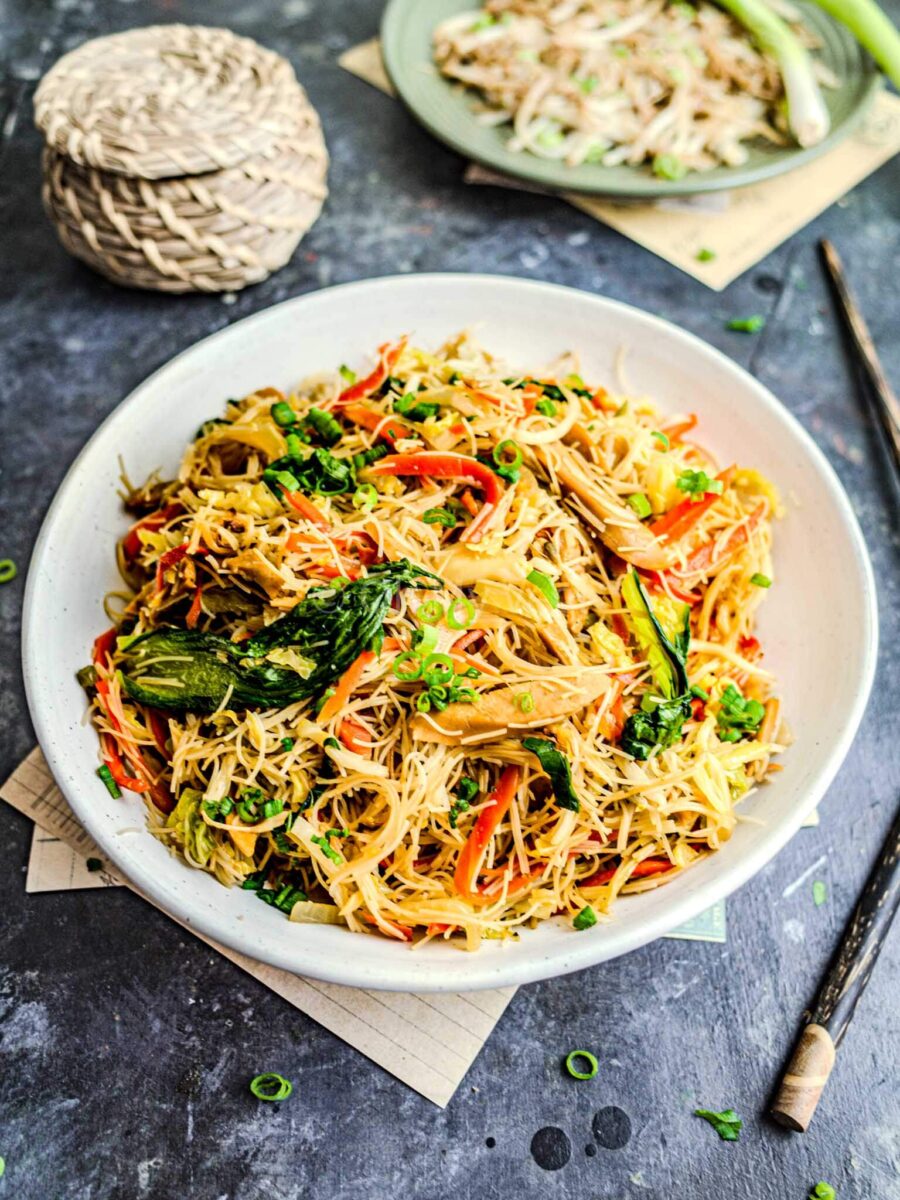
🤔 Frequently Asked Questions
🥗 Serving Suggestions
Veggie mei fun works excellently as a standalone dish. However, you can’t go wrong with some fresh sides — imagine smashed cucumber salad, garlic-sauteed greens, or crispy mushroom wontons.
Don’t limit yourself to Asian-only dishes, either.
Breaded cauliflower nuggets, cheesy corn samosas, Japanese-style tempura seaweed chips, or even Haiiwan watercress tofu salad would make for a sensational match-up!
If you tried veggie mei fun — or any other recipe on my website — please leave a 🌟 star rating and let me know your thoughts in the ✍️ comments at the bottom of the page. Thanks for being a part of my community!
Veggie Mei Fun, Vegetable Chow Mai Fun
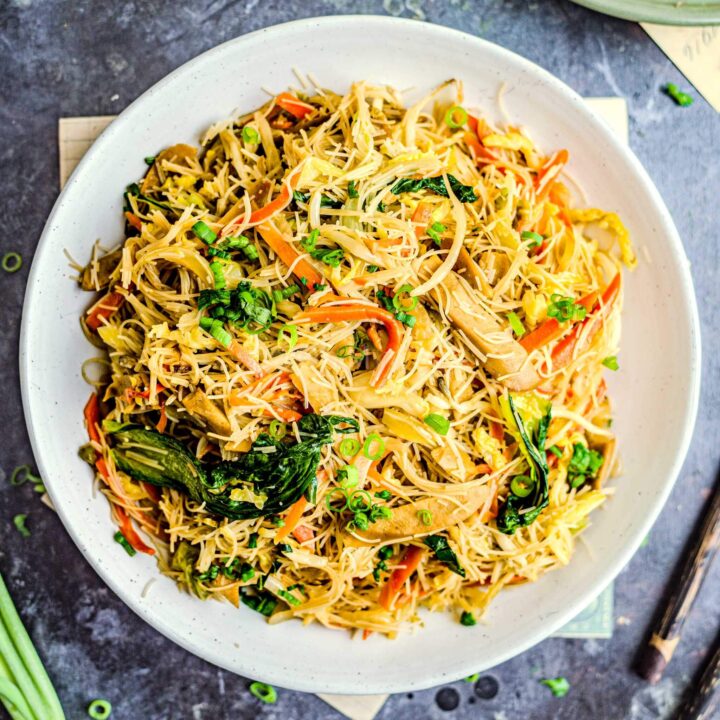
Rice noodles tossed with fresh vegetables and umami-packed sauces: this traditional veggie mei fun is a light, healthy meal.
Ingredients
For the Noodles
- 225g Dried Rice Vermicelli Noodles (roughly half a pack)
- 2 Vegan Hot Dogs, sliced
- 100g Carrot (1 Medium-Large), julienned
- 160g Pak Choy (1 Large), sliced
- 60g Napa Cabbage, sliced
- 5 Spring Onions, sliced
- 40g Onion, sliced
- 1 tablespoon Fresh Ginger, minced
- 100g Beansprouts
For the Sauce
- 2 tablespoons Light Soy Sauce**
- 1 teaspoon Dark Soy Sauce**
- 1 teaspoon Vegan Oyster Sauce
- 1 teaspoon Sesame Oil
Instructions
Soak the Dried Rice Noodles*
- Add the dried rice noodles to a large heatproof bowl. Cover with plenty of hot water — it's crucial the water is neither boiling nor cold — and soak for 10 minutes. The noodles should loosen up yet remain slightly firm.
- Drain the rice noodles in a large colander and set aside. As a precaution, you can toss the noodles with oil to prevent them from sticking together. I usually find this unnecessary.
Cook the Stir Fry
- Heat a large wok over high heat until smoking. Once hot, add the oil and swirl around.
- Add the onion and ginger to the pan. Stir-fry for a few seconds, tossing/stirring constantly.
- Next, add the vegetables with longer cooking time to the pan. For this recipe, carrots, pak choy, and napa cabbage. Also, add your chosen protein — vegan hot dog sausages. Stir-fry for a few minutes on high heat, until the sausages are slightly charred, and the vegetables are tender but still crisp.
- Throw in the beansprouts and green onions. Stir fry for 30 seconds.
- Add the light and dark soy sauce plus vegan oyster sauce to the pan. Toss to mix with the vegetables.
- Add the soaked and drained rice noodles to the pan. Use a combination of tossing and stirring movements to mix everything well. Turn off the heat.
- Finish the dish with a drizzle of sesame oil. Garnish with spring onion greens, if desired.
Notes
* You can skip this step if you're using pre-soaked, fresh rice noodles.
** To make veggie mei fun gluten free, substitute soy sauce for tamari. You may also need to check the ingredients of the vegan oyster sauce.
Recommended Products
As an Amazon Associate and member of other affiliate programs, I earn from qualifying purchases.
Nutrition Information:
Yield:
4Serving Size:
1Amount Per Serving: Calories: 209Total Fat: 9gSaturated Fat: 3gTrans Fat: 0gUnsaturated Fat: 5gCholesterol: 14mgSodium: 897mgCarbohydrates: 24gFiber: 3gSugar: 3gProtein: 8g
Nutrition information isn’t always accurate.






